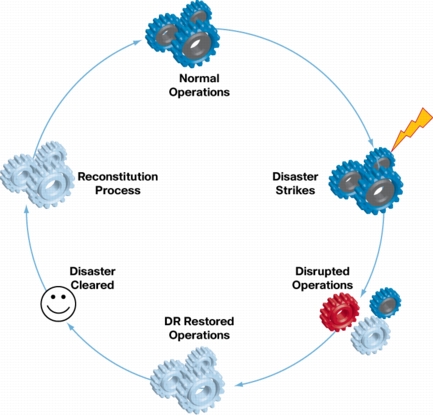4
2012
Disaster Recovery Best Practices
Disasters occur, and very rarely according to anticipated schedules. Given the overwhelming reliance on IT in most organizations a disaster has the potential to force out of business the unprepared making disaster recovery and adherence to best practices vitally important. Any organization without a disaster recovery plan is courting fate and is unlikely to survive.
Disaster recovery in an IT context is not the same as high availability and the two should not be confused, yet in many organizations this is the case. High availability defines a network that is online most of the time, yet even the best planning cannot completely eliminate downtime caused by disaster such as staff being unable to enter the workplace and implement the disaster recovery plan.
Yet despite the obvious differences, following best practices is capable of narrowing the gap and in less serious disasters it may be possible for a network to remain operational even if large parts of it are incapacitated or destroyed. Actively seeking the advice of disaster recovery experts and vendors at the planning stage brings relevant expertise into play.

Ensure the plan can be implemented by staff outside of the planning process, the authors may be unavailable in a disaster or may have left the organization so clearly written policies and procedures are desirable outcomes. Using plain English understood outside of the IT world, and providing training to all staff on disaster preparedness is likely to offer more opportunities of successful recovery.
An audit of the disaster recovery plan at regular intervals, perhaps every year, and empowering staff to actively engage the audit looking for improvements will allow better long term planning decisions to be made. The IT administrator or CIO and business continuity team need to be involved in setting the scope of the audit. At senior management level the audit report needs to be to discussed and understood in terms of contingencies and future strategic planning.
Best practices in drafting the disaster recovery plan will dictate the goals are clearly defined and written down in detail with the aim of full technical recovery despite the worst disaster that could occur. Disasters upto and including pandemics, terrorism attacks, the threat of war, and natural disasters can all be planned against.
Depending on the scope of the disaster significant parts of the business may be destroyed, but good communication of the recovery goals and procedures should be sufficient to ensure survival of the business. Documenting data restoration procedures along with visual media such as screenshots or video presentations, along with locations of supplies and media satisfies common best practice guidelines.
A full test of the disaster recovery plan, and regular testing of isolated parts of the plan highlights any issues that could arise during an actual disaster. Simulations should not be relied on to identify potential problems, as it might not uncover issues of comprehension amongst non-IT staff or potential resourcing issues from senior staff not being available as might be the case if passwords, PIN numbers, or keys are required as part of the restoration.
Further readings
Advertisements
Recent Posts
- What is a Disaster Recovery Data Center
- What is a Relational Database?
- What is a Flat File Database?
- What is a DSN or Database Source Name?
- What is a Disaster Recovery Plan?
- What is an Open Source Database?
- What is Disaster Recovery?
- What is a Database Cluster?
- What are Database Servers?
- What are Database Forms?

 An article by
An article by 




